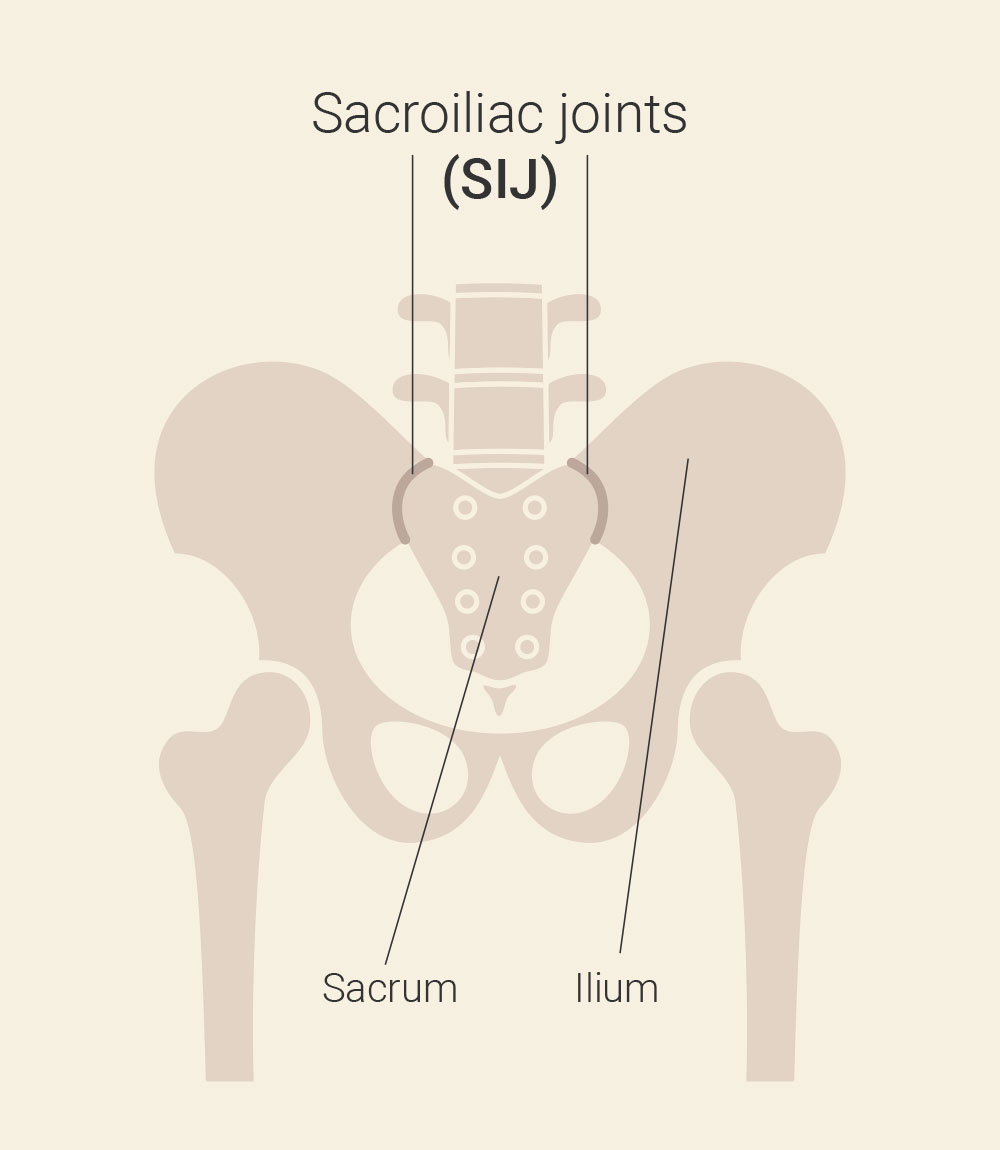Although the sacroiliac joint (SIJ) appears inconspicuous at first glance, it can cause considerable discomfort and pain in many people. This small but extremely important joint connects the sacrum to the two pelvic bones and plays a crucial role in the stability of the entire musculoskeletal system. If the sacroiliac joint does not function properly, this can lead to back and pelvic pain, restricted mobility and more. A key question for sufferers is: how can these SIJ problems be alleviated? In the case of SIJ pain, it is first important to carry out a comprehensive diagnosis to find out exactly where the pain is coming from. Depending on the diagnosis, we can draw up an individual treatment plan for you.

SIJ: What is the sacroiliac joint and what does it do?
The sacroiliac joint (SIJ) is a joint in the human body that is located between the pelvic bone (ilium) and the sacrum. This joint belongs to the category of amphiarthrosis joints, which means that its mobility is limited.
The sacroiliac joint has two important functions:
Providing stability
The joint plays a crucial role in maintaining the correct position of the pelvis. It also controls the movements between the pelvis and the spine. This stabilization is crucial for the upright posture and balance of the body.
Shock absorption
The sacroiliac joint also acts as a shock absorber. It absorbs shocks and stresses during activities such as walking, running or jumping. The joint distributes these forces evenly across the pelvis and spine to prevent injuries.

Various problems can cause SIJ pain
There are different types of problems that can be associated with the sacroiliac joint (SIJ). They can be accompanied by a wide range of complaints and symptoms. In most cases, there is sometimes severe pain in the lower back, buttocks, hips or legs. The pain is often worse when you stand, walk, bend or turn. Sometimes numbness or tingling can also occur.
The most common SIJ problems and clinical pictures include:
Dysfunction of the sacroiliac joint
In sacroiliac joint dysfunction, the joint does not function as it should, often due to overuse, trauma or misalignment. This can lead to pain, stiffness and limited mobility. This finding occurs quite frequently.
Arthritis of the SI joint
In arthritis, a joint is inflamed. This clinical picture can also affect the sacroiliac joint.
Pregnancy-related SIJ problems
During pregnancy, the connective tissue in a woman’s body loosens to make room for the growing baby. This can lead to the sacroiliac joint becoming unstable. This can be accompanied by pain.
Injuries to the sacroiliac joint
Traumatic injuries such as falls or accidents can affect the sacroiliac joint.
These are often referred to as SIJ syndrome. This term is used as a collective term for the various problems that can affect the sacroiliac joint.
Diagnosis of SIJ pain
Medical history and physical examination
First, we take a careful, detailed medical history. We will ask you about your symptoms, your medical history and possible injuries or traumatic events (such as accidents or falls). We will then carry out a physical examination. We will have you make certain movements, palpate you and carry out tests with you to determine the exact location of the symptoms. By applying pressure to the sacroiliac joint, for example, we can check whether this is already causing pain. This is an indication of SIJ syndrome.
Exclusion of other causes using imaging procedures
As the symptoms of SIJ syndromes can be similar to those of other lower back conditions, it is important to rule out other possible causes. These include, for example, bulging discs, slipped discs or hip problems.
For differential diagnoses, we use imaging techniques such as ultrasound and X-rays. If these are not informative enough, we can use MRI (magnetic resonance imaging) or CT scans. These diagnostic methods can help to detect structural anomalies or changes in the area of the sacroiliac joint.
SIJ pain: treatment options in our practice in Frankfurt
The treatment of sacroiliac joint problems depends on your exact diagnosis and your individual circumstances and needs. In principle, the following treatments are possible at our private practice for orthopaedics and traumatology in Frankfurt:
Drug therapy
For acute and basic treatment, we can prescribe painkillers or anti-inflammatory medication to alleviate your symptoms. In some cases – especially if the muscles surrounding the SI joint are particularly tense – muscle relaxants are also useful. These are medications with special active ingredients that reduce and relieve muscle tension and muscle spasms.
Injections
For severe pain, we can inject local anesthetics and/or anti-inflammatory medication into your SI joint. There are various options for this in spinal therapy (e.g. neural therapy, segmental therapy, infiltrations close to the spine). The aim of the treatment is to relieve your pain and reduce any existing inflammation.
Chiropractic therapy
Chiropractic treatment is a form of manual therapy that we also offer at our practice in Frankfurt. Chiropractic treatment can help with SI joint problems in various ways: Firstly, it can restore the flexibility of your joint and thus improve your mobility. If the sacroiliac joint is displaced or misaligned, we can bring it back into the correct position. This can relieve pain and discomfort. Furthermore, the targeted manual techniques can help to relieve muscle tension around the sacroiliac joint.
Traction treatments
Traction is a method in which we apply controlled traction forces to your spine and the affected joint. Traction treatments can be particularly helpful if compression or misalignment of the sacroiliac joint is causing the symptoms. This can lead to unusual pressure on the joint. We can reduce the pressure through traction. We can also improve mobility if the function of the SIJ is restricted, e.g. due to adhesions. The treatment can also help to relax the muscles around the sacroiliac joint. In many cases, this all helps to improve the symptoms.
Acupuncture
Another option for treating SIJ pain is acupuncture. This is a traditional Chinese healing method in which we insert thin needles into your skin at specific points. Your body then releases endorphins – your body’s own pain-relieving substances. We can also use the needles to help relieve muscle tension. Acupuncture also improves blood circulation, which can further promote healing.
Complementary methods to treat SIJ problems
Physiotherapy
Physiotherapists can support the treatment of SIJ pain. They use targeted manual techniques and show you exercises to strengthen your muscles and improve the mobility of the sacroiliac joint. This can help to stabilize the joint and increase your freedom of movement.
Osteopathy
This holistic medical approach uses special manual techniques to diagnose, treat and prevent functional disorders and imbalances in the body. This concept can also be used to support the treatment of SI joint pain.
Sport or MTT
With a targeted training plan tailored to your symptoms, you can strengthen the muscles surrounding the SI joint and achieve improved stability. Medical training therapy (MTT for short) is also ideal for this.
Treating SIJ pain in Frankfurt
Pain originating from the sacroiliac joint can be very stressful and grueling – especially if it is particularly severe. At our practice in Frankfurt, we carry out a thorough diagnosis to determine the source of your pain and then draw up a treatment plan that is tailored to your individual situation.
We are here for you and won’t leave you alone with your pain! Simply contact us to make an appointment!
Image sources: 568626012 © Tarokmew | 667297518 © pikovit | stock.adobe.com